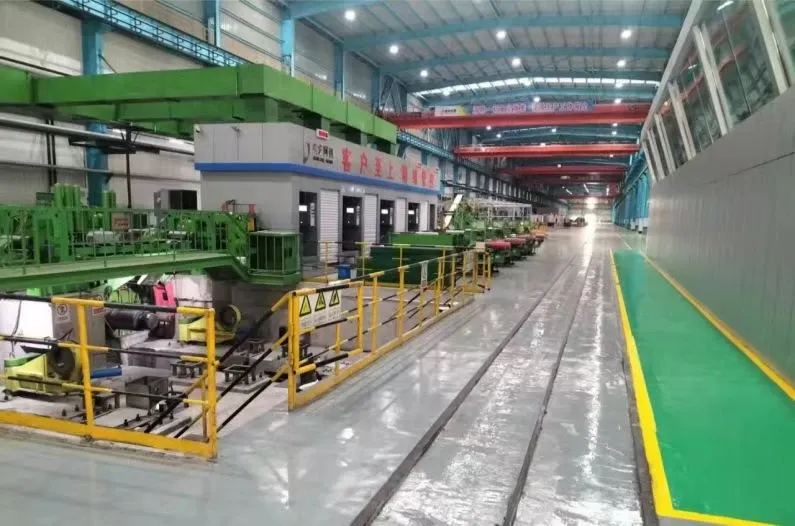
What Is the Difference Between Hot Rolling Mill and Cold Rolling Mill?
The most fundamental distinction between hot rolling mills and cold rolling mills lies in the temperature at which metal deformation occurs. Hot rolling mills process metal above its recrystallization temperature—typically between 1,100°C and 1,300°C for steel—allowing for easier shaping and reduced resistance to deformation. This high-temperature processing enables the production of large-scale structural components such as beams, plates, and rails with improved mechanical properties through grain refinement.

In contrast, cold rolling mills operate at or near room temperature, working with metal that has already been hot-rolled. The absence of heat means the metal retains higher strength and hardness due to work hardening, making it ideal for precision applications like automotive body panels, appliances, and thin-gauge steel sheets. The cold rolling process also enhances surface finish and dimensional accuracy, which is critical for industries requiring tight tolerances.
Hot Rolling Mills and cold Rolling Mills Characteristics and Applications
The products from hot rolling mills and cold rolling mills serve vastly different market needs due to their distinct mechanical properties. Hot-rolled products, such as structural steel, shipbuilding plates, and railway tracks, exhibit greater toughness and ductility, making them suitable for heavy-duty construction and industrial applications. The slightly rougher surface finish of hot-rolled metal is acceptable in these cases, where surface aesthetics are secondary to structural integrity.
On the other hand, cold-rolled products, including automotive sheets (e.g., DX51D, SPCC), stainless steel strips, and precision tubes, offer superior surface quality, tighter thickness control, and enhanced strength. These characteristics make them indispensable in industries such as automotive manufacturing, electronics, and high-end appliances. Companies like YWLX specialize in cold rolling mill solutions, including reversing cold rolling mills (RCM), tandem cold rolling mills (TCM), and temper mills, which are essential for producing these high-precision materials.
Hot Rolling Mills and cold Rolling Mills Equipment and Technological Requirements
The machinery used in hot rolling mills and cold rolling mills differs significantly due to their operational demands. Hot rolling mills require robust, high-capacity equipment capable of withstanding extreme temperatures, including heavy-duty rolling stands, descaling systems, and cooling beds. These mills often operate as part of continuous production lines, such as hot strip mills (HSM), where metal is rolled in multiple passes to achieve the desired thickness.
Conversely, cold rolling mills demand advanced precision control systems, such as Automatic Gauge Control (AGC) and tension leveling mechanisms, to ensure uniform thickness and superior flatness. Technologies like skin pass mills and temper mills are integrated to enhance surface finish and mechanical properties. YWLX’s expertise in cold rolling mill systems, including pickling-tandem cold rolling lines (PL-TCM) and continuous galvanizing lines (CGL), highlights the importance of automation and precision in cold rolling operations.
Hot Rolling Mills and cold Rolling Mills Material Properties and Post-Processing Needs
The choice between hot rolling and cold rolling also depends on the desired material properties and subsequent processing requirements. Hot-rolled metals typically undergo minimal post-processing, as their primary purpose is structural strength rather than surface refinement. However, they may require shot blasting or machining to remove scale and improve surface condition for certain applications.
Cold-rolled metals, however, often undergo additional treatments such as annealing, galvanizing, or coating to enhance corrosion resistance, formability, and aesthetic appeal. Processes like continuous annealing lines (CAL) and continuous galvanizing lines (CGL) are critical for producing high-quality cold-rolled sheets for automotive and construction industries. The ability to tailor material properties through cold rolling and subsequent treatments makes it a preferred method for high-value applications.
Hot Rolling Mills and cold Rolling Mills Economic and Operational Considerations
From an economic perspective, hot rolling mills are generally more cost-effective for large-scale production due to lower energy consumption per ton of processed metal and faster throughput rates. However, the trade-off is reduced precision and surface quality, which may necessitate secondary processing for certain applications.
Cold rolling mills, while more energy-intensive and slower, offer higher value-added products with superior mechanical and surface properties. The investment in advanced cold rolling technologies—such as those provided by YWLX—justifies the higher operational costs by enabling manufacturers to meet stringent industry standards and command premium pricing for their products.
-
Indian Clients Visit YWLX to Inspect Skin-pass MillNewsJun.22,2025
-
Typical Products from Reversing Cold Rolling ProcessNewsMay.26,2025
-
Surface Finish Improvement through Skin Pass RollingNewsMay.26,2025
-
Integration of AGC Systems in Modern Cold Rolling MillsNewsMay.26,2025
-
Cold Rolling in the Context of High-Strength Steel DemandNewsMay.26,2025
-
AGC in Hot Rolling Mills: Challenges and SolutionsNewsMay.26,2025
-
Why Reversing Cold Rolling Mills Are Ideal for Specialty MetalsNewsMay.13,2025










